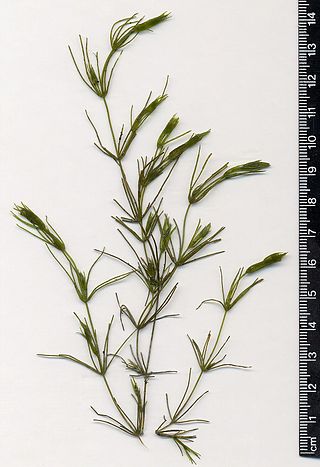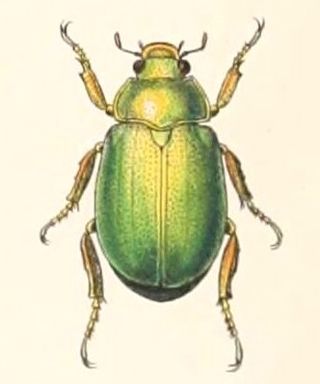
Genus is a taxonomic rank above species and below family as used in the biological classification of living and fossil organisms as well as viruses. In binomial nomenclature, the genus name forms the first part of the binomial species name for each species within the genus.

Charales is an order of freshwater green algae in the division Charophyta, class Charophyceae, commonly known as stoneworts. Depending on the treatment of the genus Nitellopsis, living (extant) species are placed into either one family (Characeae) or two. Further families are used for fossil members of the order. Linnaeus established the genus Chara in 1753.
The World Register of Marine Species (WoRMS) is a taxonomic database that aims to provide an authoritative and comprehensive list of names of marine organisms.
Neoasterolepisma is a genus of primitive insects belonging to the family Lepismatidae. Many species live with ants.
Brachypareion is an extinct genus of prehistoric marine ray-finned fish that lived during the Pennsylvanian epoch. It contains a single species, B. insperatum, known from the Saur Mountains of Kazakhstan. It is placed in the paraphyletic group Palaeonisciformes.
Microstomum is a genus of flatworms in the family Microstomidae.

The Interim Register of Marine and Nonmarine Genera (IRMNG) is a taxonomic database which attempts to cover published genus names for all domains of life, from 1758 in zoology up to the present, arranged in a single, internally consistent taxonomic hierarchy, for the benefit of Biodiversity Informatics initiatives plus general users of biodiversity (taxonomic) information. In addition to containing just over 500,000 published genus name instances as at May 2023, the database holds over 1.7 million species names, although this component of the data is not maintained in as current or complete state as the genus-level holdings. IRMNG can be queried online for access to the latest version of the dataset and is also made available as periodic snapshots or data dumps for import/upload into other systems as desired. The database was commenced in 2006 at the then CSIRO Division of Marine and Atmospheric Research in Australia and, since 2016, has been hosted at the Flanders Marine Institute (VLIZ) in Belgium.

Anostirus is a genus of beetles in the family Elateridae.
Tuberculatus is a genus of insects belonging to the family Aphididae.

Corticeus fasciatus is a species of beetle belonging to the family Tenebrionidae.
Scydmoraphes is a genus of beetles belonging to the family Staphylinidae.

Limnius is a genus of beetles belonging to the family Elmidae.

Enteridium is a genus of slime molds belonging to the family Reticulariaceae.

Dinothrombium is a genus of mites belonging to the family Trombidiidae, which are commonly known as red velvet mites. As suggested by the name, Dinothrombium are covered in fine hairs and they are bright red, sometimes with markings in paler colors. Their bright colours appear to be aposematic, hinting at their unpleasant taste and smell. They are generally fairly large for their family and the African D. tinctorum, where adults typically are 12–14 mm (0.47–0.55 in), is one of the largest known species of red velvet mites. Dinothrombium are found in all the world's continents, except Antarctica, often in dry areas, where they spend most of the time underground in the soil or sand, emerging after heavy rain. During this time, they can be conspicuous and numerous.
Ischnochitonida is an order of molluscs belonging to the class Polyplacophora.

Babesiidae is a family of protists belonging to the order Piroplasmida.
Lestonia is a genus of true bugs belonging to the monotypic family Lestoniidae.

Anoplostethus is a genus of beetles belonging to the family Scarabaeidae.
Corticeus (Stenophloeus) cephalotes is a species of darkling beetle distributed all over Oriental region and Vanuatu.

Pentacheles is a genus of crustaceans of the class Malacostraca.










